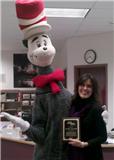Twelve year old Izzy Roybal is disappointed she’ll have to spend the summer with her grandmother in a small New Mexican village while her mother is away. But when she finds a baseball with the words “Because… magic”, it begins her on a journey of self-discovery that includes the secrets of her father’s death, and her own life.
Jenniver Cervantes’ TORTILLA SUN (Chronicle) is rich with love, family, cultural lore, and warms the reader like the glorious New Mexico sun. Jennifer was gracious enough to talk food, writing and cats with us (yes, that’s her with the Cat in the Hat).
1. Setting is so important in TORTILLA SUN. In it, the colors, tastes and flavors of a small New Mexican village come alive. Was Izzy’s grandmother’s village based on a real one?
No, the village is fictionalized, but there are many small villages still here that have a lovely old world feel to them.
How did your life in New Mexico influence this book?
New Mexico is called the Land of Enchantment and it truly is. I began writing Tortilla Sun in Santa Fe and was easily inspired by the natural landscape and beauty of the place in addition to the rich culture found here.
2. Food is another critical component of this book – empanadas, burritos and of course tortillas. You even include a recipe for tortillas in the back of the book! So tell the truth – do your tortillas come out crooked like Izzy’s or round like the sun?
Truth: CROOKED…but I have practiced and now they come out round…kind of.
How important is cooking to you?
Actually, I’m not a cook (but I do love to bake). It’s one of those things I wish I was good at, but time never seems to allow me to “play” in the kitchen. But don’t worry I don’t starve my family. I have a good ten recipes I make over and over. I know—so uncreative.
What made you incorporate food so centrally in this story? While I don’t do much cooking, I LOVE to eat and I have such fond memories of being in both my grandmothers’ kitchens and the comfort and love I felt there, so I wanted to bring some of that to this story.
Intrigued? Interested? Hungry for Tortillas? Read the reset of my interview with Jennifer HERE, at From the Mixed Up Files of Middle Grade Authors and leave a comment there to qualify to win a free copy of Tortilla Sun!
Jenniver Cervantes’ TORTILLA SUN (Chronicle) is rich with love, family, cultural lore, and warms the reader like the glorious New Mexico sun. Jennifer was gracious enough to talk food, writing and cats with us (yes, that’s her with the Cat in the Hat).
1. Setting is so important in TORTILLA SUN. In it, the colors, tastes and flavors of a small New Mexican village come alive. Was Izzy’s grandmother’s village based on a real one?
No, the village is fictionalized, but there are many small villages still here that have a lovely old world feel to them.
How did your life in New Mexico influence this book?
New Mexico is called the Land of Enchantment and it truly is. I began writing Tortilla Sun in Santa Fe and was easily inspired by the natural landscape and beauty of the place in addition to the rich culture found here.
2. Food is another critical component of this book – empanadas, burritos and of course tortillas. You even include a recipe for tortillas in the back of the book! So tell the truth – do your tortillas come out crooked like Izzy’s or round like the sun?
Truth: CROOKED…but I have practiced and now they come out round…kind of.
How important is cooking to you?
Actually, I’m not a cook (but I do love to bake). It’s one of those things I wish I was good at, but time never seems to allow me to “play” in the kitchen. But don’t worry I don’t starve my family. I have a good ten recipes I make over and over. I know—so uncreative.
What made you incorporate food so centrally in this story? While I don’t do much cooking, I LOVE to eat and I have such fond memories of being in both my grandmothers’ kitchens and the comfort and love I felt there, so I wanted to bring some of that to this story.
Intrigued? Interested? Hungry for Tortillas? Read the reset of my interview with Jennifer HERE, at From the Mixed Up Files of Middle Grade Authors and leave a comment there to qualify to win a free copy of Tortilla Sun!










